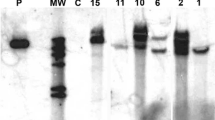Abstract
Extracts of cranberry, rich in flavonols and proanthocyanins, inactivatedβ-glucuronidase (GUS) in assays using either purified bacterial GUS or preparations of transgenic tobacco (Nicotiana tabacum L.) or transgenic cranberry (Vaccinium macrocarpon Ait.) expressing thegusA gene. Histochemical GUS assays produced random and generally unpredictable staining. The addition of poly-vinylpolypyrrolidone (PVPP) during the preparation of transgenic cranberry leaf extracts increased the detectable GUS activity in fluorogenic assays more than 200-fold. Detectable GUS activity varied among transclones and also within a transclone depending on the developmental and physiological state of the tissue, as well as the growth environment. Use of PVPP altered the relative ranking of plants based on their total transgenic enzyme activity and resulted in different conclusions as to the effects of genotype or growth environment on transgene expression.
Similar content being viewed by others
Abbreviations
- GUS :
-
β-Glucuronidase
- MUG :
-
4-Methyl umbelliferyl glucuronide
- PVPP :
-
Polyvinylpolypyrrolidone
- X-gluc :
-
5-Bromo-4-chloro-3-indolyl glucuronide
References
Allen GC, Hall GE, Childs LC, Weissinger AK, Spiker S, Thompson WF (1993) Scaffold attachment regions increase reporter gene expression in stably transformed plant cells. Plant Cell 5: 603–613
Breyne P, Gheysen G, Jacobs A, Montagu M van, Depicker A (1992) Effect of T-DNA configuration on transgene expression. Mol Gen Genet 235: 389–396
Callis J, Raasch J, Vierstra R (1990) Ubiquitin Extension Proteins inArabidopsis thaliana: Structure, Localization, and Expression of Their Promoters in Transgenic Tobacco. J Biol Chem 265: 12486–12493
Dong J-Z, Yang M-Z, Jia S-R, Chua N-H (1991) Transformation of melon (Cucumis melo L.) and expression from the cauliflower mosaic virus 35s promoter in transgenic melon plants. Biotechnology 9: 858–863
Ellis DD, McCabe D, Russell D, Martinell B, McCown BH (1991) Expression of inducible angiosperm promoters in a gymnosperm,Picea glauca (white spruce). Plant Mol Biol 17:19–27
Finnegan J, McElroy D (1994) Transgene inactivation: plants fight back! Biotechnology 12:883–888
Gallagher SR (1992) GUS protocols: using the GUS gene as a reporter of gene expression. Academic Press, San Diego
Gao J, Lee JM, An G (1991) The stability of foreign protein production in genetically modified plant cells. Plant Cell Rep 10:533–536
Graham J, McNichol RJ, Kumar A (1990) Use of the GUS gene as a selectable marker forAgrobacterium-mediated transformation ofRubus. Plant Cell Tissue Organ Cult 20: 35–39
Grimmer HR, Parbhoo V, McGrath RM (1992) Antimutagenicity of polyphenol-rich fractions fromSorghum bicolor grain. J Sci Food Agric 59: 251–256
Harborne JB (1984) Phytochernical methods: A guide to modern techniques of plant analysis, 2nd ed. Chapman and Hall, London, pp 37–99
Hesper JPFG, Kolodziej H, Hoogendi JM, Norel A van (1993) Characterization and trypsin inhibitor activity of proanthocyanins fromVicia faba. Phytochemistry 34: 1255–1260
Hobbs SLA, Warkentin TD, DeLong CMO (1993) Transgene copy number can be positively or negatively associated with transgene expression. Plant Mol Biol 21: 17–26
Jefferson RA (1987) Assaying chimeric genes in plants: the GUS fusion system. Plant Mol Biol Rep 5:387–405
Jefferson RA, Kavanaugh T, Bevan MW (1987) GUS fusions:β-glucuronidase as a sensitive and versatile gene fusion marker in higher plants. EMBO J 6:3901–3907
Loomis WD (1974) Overcoming problems of phenolics and quinones in the isolation of plant enzymes and organelles. Methods Enzymol 31: 528–544
Ottaviani M-P, Smits T, Hanisch ten Cate C (1993) Differential methylation and expression of theβ-glucuronidase and neomycin phosphotransferase genes in transgenic plants of potato cv. Bintje. Plant Sci 88:73–81
Phillips JP, Xing T, Gartland JS, Gartland KMA, Elliott C (1992) Variation inβ-glucuronidase activity of clones of transformed sugar beet roots. Plant Growth Regul 11: 319–325
Reed JD, Horvath PJ, Allen MS, Van Soest PJ (1985) Gravimetric determination of soluble phenolics including tannins from leaves by precipitation with trivalent ytterbium. J Sci Food Agric 36: 255–261
Serres R, Stang E, McCabe D, Russell D, Mahr D, McCown B (1992) Gene transfer using electric discharge particle bombardment and recovery of transformed cranberry plants. J Am Soc Hort Sci 117:174–180
Vainstein A, Fisher M, Ziv M (1993) Application of reporter genes to carnation transformation. Hort science 28: 1122–1124
Vaithiyanathan S, Kumar R (1993) Relationship between protein-precipitating capacity of fodder tree leaves and their tannin content. Anim Feed Sci Technol 44: 281–287
Wilde HD, Meagher RB, Merkle SA (1992) Expression of foreign genes in transgenic yellow-poplar plants. Plant Physiol 98: 114–120
Author information
Authors and Affiliations
Additional information
Communicated by J. J. Finer
Rights and permissions
About this article
Cite this article
Serres, R., McCown, B. & Zeldin, E. Detectableβ-glucuronidase activity in transgenic cranberry is affected by endogenous inhibitors and plant development. Plant Cell Reports 16, 641–646 (1997). https://doi.org/10.1007/BF01275507
Received:
Revised:
Accepted:
Issue Date:
DOI: https://doi.org/10.1007/BF01275507




